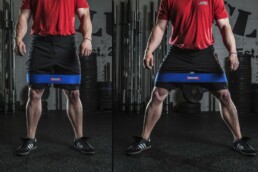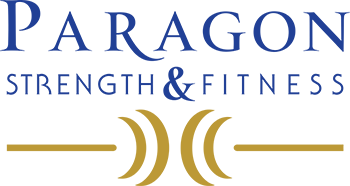A workout warm-up should be targeted to affect several things: promote an increase in core body temperature and blood flow, to increase muscle-tendon suppleness, and to enhance free coordinated movements, which, in turn, help prepare the body for exercise.(2) When performed correctly, doing a warm-up before workouts can enhance the body’s overall performance in that workout. Warm-up movements should change based on your specific workout for the day; if you have a challenging leg day scheduled, your body will respond better to activation and warm-up movements specific to your legs.
Movements specific warm-ups are also incredibly useful. Essentially, if you are going to be doing some sort of squat in your workout, you should do some variation of squatting in your warm-up. This could be a squat performed with a band around your knees to increase glute activation, or even a shallow single-leg squat to a bench to warm your quads up. The same goes for any upper body workouts. If you are doing a barbell bench in a workout, you should do some sort of horizontal pressing to warm up. This could be a regular pushup, an incline pushup or a plyometric medicine ball push to prepare your body for the given movement you are going to be performing.
Is it Important to Warm-Up Before a Workout?
Not only is it important, but studies show that dynamic warmups(think lunging, overhead reaches, high knees, lateral shuffles) increase the overall performance of the workout.(1) A strength training warm-up can prepare you for any movement you might encounter in a workout. A warm-up before a workout can also counteract your daily routine. You may find yourself waking up, sitting in the car during your commute to work, sitting at work and then sitting in the car on the way to your workout. This can cause some tight hips, legs or lower back symptoms. A dynamic warmup before you perform your workout can help get the juices flowing and help mitigate some of these symptoms.
How Long Should I Warm-Up For?
Most good workout warm-ups are around 10-15 minutes. As mentioned above, you want to MOVE during your warm-up. Studies have been conducted that compare the results of a dynamic warm-up to a static stretching warm-up. The dynamic warm-up group in each study showed increases in every testing category, while groups who performed the static stretching protocol didn’t progress and even lost percentages of several tested categories.(1)
A warmup that is 10-15 minutes long may not be feasible in your schedule. But remember, even a 5-minute dynamic warm-up is better for you than coming in completely cold to a workout. If you ask any coach, they should be able to prescribe a good warm-up before workouts for you. If you do have the ability to come in early before your session/class/private training session, make sure you take advantage of the time you have and move!
Are Warm-Up Sets Necessary?
Absolutely. Everyone regardless of training style should warm-up before workouts. Maybe you follow more of a 15,12,10 reps scheme in your workouts, or you are a weightlifter that does a standard 5×5 reps scheme for your big lifts, you absolutely need to hit some sets prior to your working sets to warm up. Warm-up sets don’t only prime your body for heavier/high rep sets, but they can give you a glimpse as to how your body feels on that given day. If you are a little more worn down or have more soreness than you expected, jumping straight into heavy sets can increase the risk for injury.

Glute activation is key to a successful leg day!
What Are Good Warm-Up Exercises?
This could be quite the extensive list if we give you all of our utilized workout warm-ups. These warm-ups can vary between clients based on age, given sport(if applicable), current injuries/imbalances or even time allotted to warm-up. Instead, we will break down our favorite workout warm-ups categorized by specific training days.
Let’s pretend you have a leg day today. Here are some lower body specific workout warm-up movements:
- A lateral banded walk, followed by a forward and backward banded walk. We prefer to use the Hip Circle bands from Mark Bell.
- Straight leg kicks – usually the length of our main gym floor area, roughly 25 yards.
- An alternating quad stretch, or a quad stretch with toe touch if you are working on balance as well.
- A lunge plus an overhead reach.
- Over/under lateral steps.
- Alternating external hip rotations.
- Quick high knees (Athletes)
- Broad jump, either single leg or bilateral (Athletes)
These movements are performed in succession with little to no rest between movements. The goal again to promote an increase in core body temperature and blood flow, to increase muscle-tendon suppleness, and to enhance free coordinated movements. These movements are wonderful if you need a specific strength training warm-up, or even if you are just warming up for a whole-body day.
You’ve just walked into the gym and it’s an upper-body day for you. Here are some upper body workout warm-up movements:
- Banded shoulder activation: This may vary based on the client, but the most common movements are banded Y’s, T’s, W’s and internal/external rotations.
- Dumbbell Internal Rotations
- Scapular Pushups or Pullups
- Band Pull-Overs
- Recline Pulls
- Cuban Press (either dumbbell or a light bar)
- Plyometric Pushups (Athletes)
Whether you are a regular gym-goer that needs a good warm-up before workouts, or you are an athlete that needs a specific strength training warm-up, feel free to contact us! We would love to chat about your specific warm-up needs and help you stay injury-free.
References https://journals.lww.com/nsca-jscr/fulltext/2008/07000/Four_Week_Dynamic_Stretching_Warm_up_Intervention.36.aspx(1) https://www.ncbi.nlm.nih.gov/pubmed/16937960(2)
